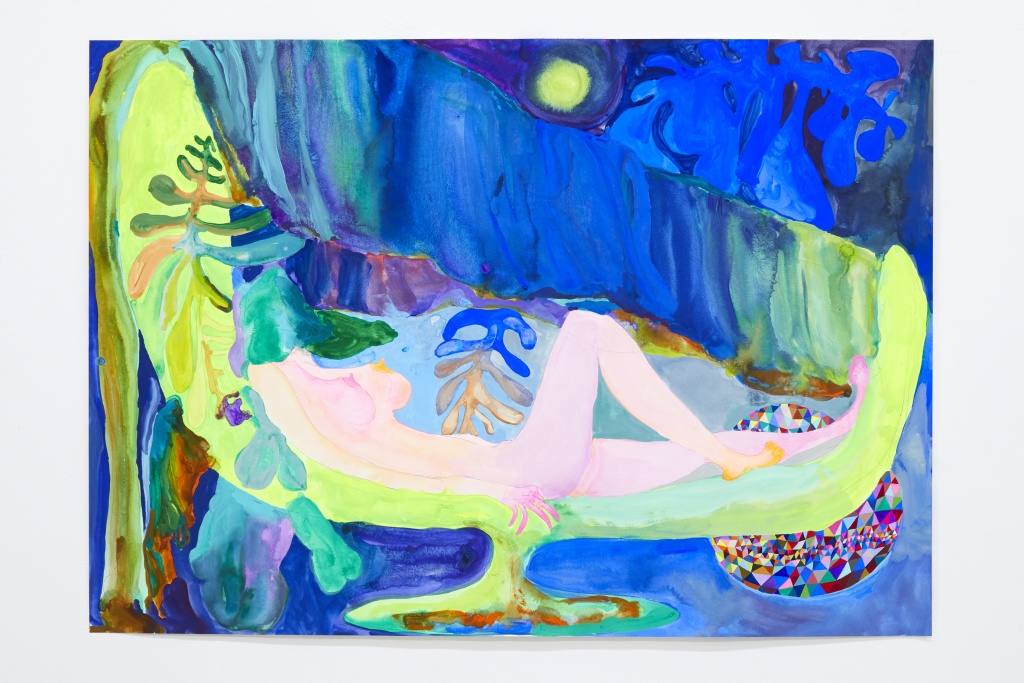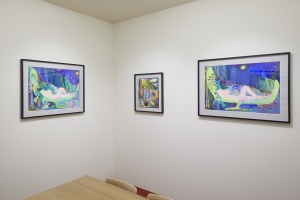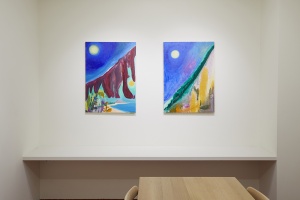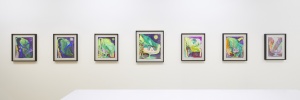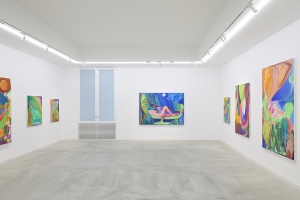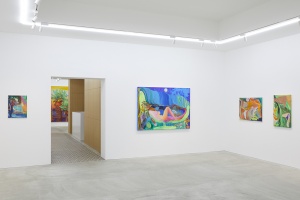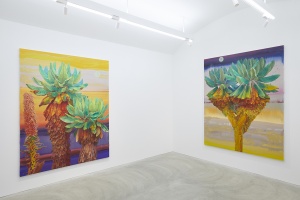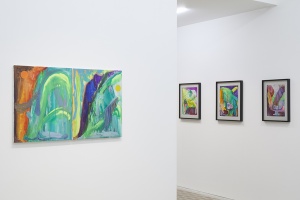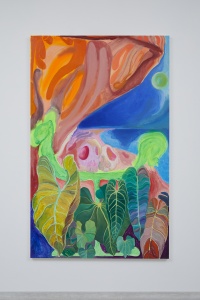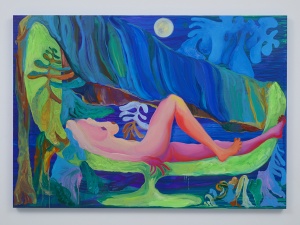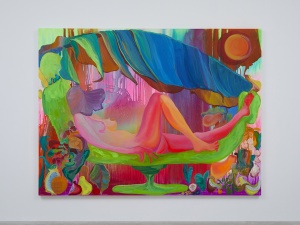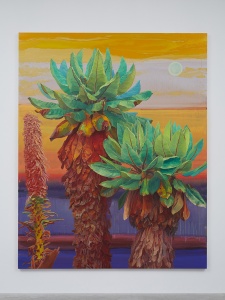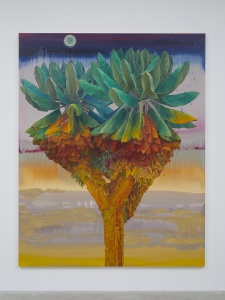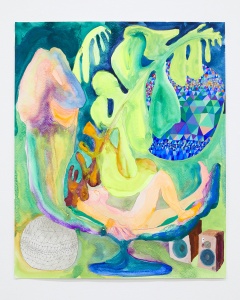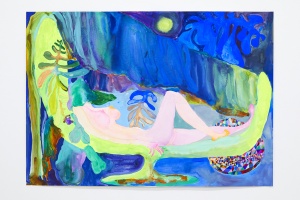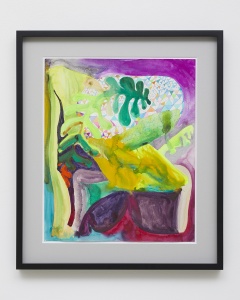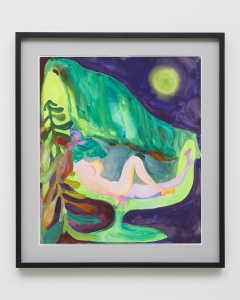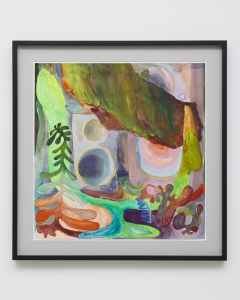Tomio Koyama Gallery is pleased to present “Sleep in jungle.,” an exhibition with Satoshi Ohno. The exhibition marks Ohno’s 5th solo presentation with the gallery, and introduces a selection of drawings and paintings that reflect a new sense of direction in the artist’s practice.
A Happy and Fantastical World Where Dignity of Nature, Human Desires, and Dreams Come Together
Ohno’s Endeavors for a New Painterly Expression
【About the Exhibition and Ohno’s New Works】
Satoshi Ohno was born in 1980 in Gifu, Japan. He received a B.A. from Tokyo Zokei University in 2004. In the same year, he participated in the Koshikijima Art Project in the Kagoshima Prefecture. The “Sleep in Jungle.” series was born through combining his memories of residing on the island, and life in his Tokyo apartment equipped with large speakers. Ohno’s new works featured in this exhibition draws connections to the “Sleep in Jungle.” series, and depict happy and fantastical worlds in which subtropical jungles appear to encompass, blend into and assimilate with dreams.
The bed is a large vessel and a male representation, upon which a female figure is seen lying down in a comfortable doze. This expression of love and affection between a man and woman amidst the rich foliage of plant life, indeed serves to reflect Ohno’s attempt in exploring “the extent to which it is possible to depict inherent human senses.” In recent years, Ohno’s landscape paintings have been characterized by their excessive overlapping of layers, seemingly drawing links to multi-layer images as observed in computer windows and movies, and the multi-layer structure of contemporary society. In this exhibition however, he takes on an entirely different approach, painting with a palette of freshly vivid colors in a way that the background and figures depicted blend into form a single picture plane. His new means of composition captures human subjects and as well as entire spaces, and incorporates them into the realm of painting. Ohno’s works have an indescribable sense of unity, and are imbued with a certain power to absorb spatiality, passages of time, the perspective of viewers, and his “self,” so that they appear to dissolve into a single image.
The greens used in Ohno’s paintings, rather than being those that are found in nature, are more reminiscent of a polluted chemical green. This could be described as a conveying the connection between nature and the various issues that lurk in contemporary times.
【Satoshi Ohno and His Works: Primeval Forests and Physicality, Plants and Prisms】
Primeval forests have a significant meaning in Ohno’s work. After participating in the Koshikijima Art Project in 2004, he visited the primeval forests of Hokkaido and the Cayman Islands in the Caribbean. Having gained inspiration from the overwhelming power and vivid impressions of life, death, and maternal nurture of such forests, he relocated the base of his life and practice to Fuji-yoshida at the foot of Mt. Fuji. Ohno explored the new and acute sensitivity he felt day-to-day through his comparisons between contemporary society and primeval forests, sublimating his physical connection to the natural world into his own form of expression.
To this day, he has explored various methods of expression. In “acid garden,” his first solo exhibition with the gallery in 2006, Ohno presented an installation that consisted of large paintings including an androgynous self-portrait and a series of landscapes, three-dimensional objects, wood, soil, an orange-colored hose, and sand patterns across the floor. In “Fukutake House 2009: Echigo-Tsumari Art Triennale,” he created a space reminiscent of a primeval forest inside the building of a former school through installing an array of various paintings. The installation had evoked an almost disquieting and wild atmosphere.
From early on in his practice, he has also continued to create his “Prism” series. The series is based on Ohno’s own experience of witnessing moths attracted to the light of a street lamp, despite them being destined to be eaten by a gecko that waited there. The works reflect the impact of artificial light observed from the eyes of a moth, the ephemerality of flying to the light even should death await, and the nature contemporary civilization that continues to consume its riches until its ultimate demise. They could also be regarded as ultimate expressions of beauty based on scientific research on light, while at the same time expressing closed atmosphere of our contemporary times, and the confrontation and fusion of artificial and natural.
【Consideration for the Climate and Natural Features, Eastern and Western Art History: Painting in the Digital Age】
What also lies in the background of Ohno’s practice is a profound analysis of Eastern and Western art history, and painterly expression.
In 2013, Ohno received a grant from the Daimler Foundation, which gave him the opportunity to stay in Berlin. During the residency he spent time intensely viewing works of German Expressionism that had served to influence him. As he himself describes the construction of culture and art as reverting to the simple issue of “climate,” he studied pictorial aesthetics that arose and were cultivated through different expressions of light, fog and clouds between European paintings (i.e. German Romantic painter Caspar David Friedrich) and Japanese paintings (i.e. Hasegawa Tohaku). His experience of this awareness were conveyed in his paintings exhibited in “Art Scope 2012-2014: Remains of Their Journeys” at the Hara Museum of Contemporary Art in Tokyo in 2014. It was here that he developed expressions based on motifs of “plants,” which are directly influenced by the environment and climate in which they grow.
In this respect, motifs such as self-portraits, androgynous figures, primeval forests, subtropical plants, and prisms came to be important elements of Ohno’s work. At the same time, he continues to pursue the potential of pictorial expression in the digital age of the 21st century, overlaying active lines and brushstrokes that could be described as a layering of senses. His pictorial representation antagonizes flat color compositions on a canvas surface, thereby creating spaces in the form of an image across a two-dimensional plane. His work is included in public collections such as Hara Museum of Contemporary Art (Tokyo), National Gallery of Victoria (Australia), The National Museum of Art, Osaka, The JAPIGOZZI Collection and Sigg Collection.
Ohno has continued to express and pursue the inner nature of his “self” that exists in both nature and society in a manner that could be regarded as his very own means of expressionism.
Art critic David Elliot (former director of Mori Art Museum), writes as follows regarding Ohno’s nature as an artist.
“The obvious fact that he is a Japanese artist does not seem to be such a big deal for Ohno. There is a self-confidence and skill with which he appropriates tradition, feeling, and style to make them his own. After all, is this not what artists have always done throughout history, wherever they have lived?”
(David Elliot, “From Garden to Prism –A year in the work of Satoshi Ohno,” ritual TEAM 08 Satoshi Ohno, exhibition catalog, Tokyo Wonder Site Shibuya, Tokyo, 2007)
It serves to reflect the determination of the artist living in the present and the future, who despite being contaminated by various things and subjected to hardships, never ceases to confront them head on. What do the changes in Ohno’s work, which harbors this sense of contemporaneity, foresee and suggest? We welcome viewers to witness and embrace the vivid worlds that unfold in the artist’s latest works.
—————————————————————————————–
For press inquiries, please contact:
press@tomiokoyamagallery.com (Makiko Okado)
—————————————————————————————–

